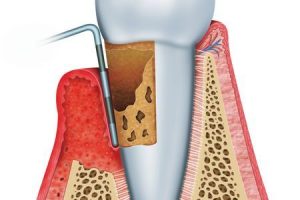 The jawbone is an essential part of your face. It provides structure to your facial features and allows you to chew and speak properly. When you experience bone loss in the jaw, it can affect numerous other aspects of your oral and overall health. Atrophy in the jaw can stem from a variety of causes, including tooth loss, gum disease, and certain medical conditions. Left untreated, jawbone loss can result in issues with your remaining teeth, collapse or distortion of facial features, and a range of other concerns. The most common treatment for jawbone atrophy is a dental bone graft. If you are concerned about potential bone loss in your jaw, speak to your dentist right away. They can recommend the best treatment route for you.
The jawbone is an essential part of your face. It provides structure to your facial features and allows you to chew and speak properly. When you experience bone loss in the jaw, it can affect numerous other aspects of your oral and overall health. Atrophy in the jaw can stem from a variety of causes, including tooth loss, gum disease, and certain medical conditions. Left untreated, jawbone loss can result in issues with your remaining teeth, collapse or distortion of facial features, and a range of other concerns. The most common treatment for jawbone atrophy is a dental bone graft. If you are concerned about potential bone loss in your jaw, speak to your dentist right away. They can recommend the best treatment route for you.
Signs of Dental Bone Loss
Many patients with periodontal disease or missing teeth will experience bone loss in their jaw as a result. In general, the process is gradual and you may not immediately notice that your jawbone is atrophying. The most effective way to diagnose tissue loss in your jaw is to visit your dentist. They can use x-rays and cone beam imaging to assess the density of your jaw and determine if you need treatment.
While the most common causes are tooth loss and gum disease, a range of other issues can lead to tissue loss in your jaw.
Certain changes in your facial features and bite can indicate jawbone loss. When tissue volume decrease in your jaw, you may notice that your mouth seems to collapse into your face, your chin becomes more pointed, or wrinkles begin to form around the mouth. In addition, denture-wearers often experience changes in the fit and comfort of their restorations due to bone loss. Your teeth may also begin to shift forward in your mouth.
What Causes Bone Loss in the Jaw?
Jawbone loss can stem from many causes. While the most common causes are tooth loss and gum disease, a range of other issues can lead to tissue loss in your jaw. For example, smoking can affect the density of bone in all areas of the body, including the jaw.
Missing Teeth
Your teeth help maintain the natural height and thickness of your jawbone. The section of bone surrounding the roots of your teeth is known as the alveolar bone. Throughout your daily life, the roots stimulate this section of the bone, indicating to the brain that resources are necessary in a particular area of the jaw. Based on this stimulation, the body sends calcium and other nutrients to the jaw, encouraging continued bone growth.
When a tooth is extracted or lost due to trauma, there are no longer roots to stimulate the alveolar bone. Over time, the body stops sending resources to the area where the tooth was and that section of the jaw will slowly deteriorate. The longer missing teeth are left untreated, the more tissue is lost until the bone beneath neighboring teeth is affected, which can cause further tooth loss.

Periodontal Disease
Chronic infection in the gum tissue, known as periodontal disease, affects tooth-supporting structures, such as the alveolar bone and other ligaments. In advanced stages, the bacteria associated with periodontal disease begins to eat away at supporting gum and bone tissue, causing tooth loss and bone loss in the jaw.
Since many of the symptoms of gum disease are painless, this condition often goes unnoticed for long periods of time. When periodontal disease is left untreated, it can cause serious damage to the strength and stability of your jaw.
Dentures and Bridgework
Traditional methods of replacing lost teeth include dentures and dental bridges. These restorations can replace missing teeth to create a more natural smile and improve your ability to eat and speak naturally. However, dentures and bridges do not protect your jaw against bone loss.
Bridges consist of artificial teeth supported by dental crowns. Since the crowns are placed over natural teeth, the jawbone beneath these teeth remains in tact. Unfortunately, the areas of jaw where teeth were lost will continue to lose tissue.
Dentures, on the other hand, can actually exacerbate jawbone loss. Traditional full dentures rest directly on the gum tissues without support from teeth or dental implants. They do not provide sufficient stimulation to prevent tissue deterioration. In addition, dentures tend to shift against the gum tissue and rub. Over time, this process can speed the loss of tissue in the jaw.
Medical Conditions
Certain medical conditions increase your likelihood of jawbone atrophy. Osteoporosis, a conditions which causes the bones to become weak and brittle, can affect the jaw and lead to deterioration of the tissue. Paget’s disease of bone (PDB), a disease that disrupts the natural replacement of old bone tissue with new, and osteomyelitis, a type of inflammation of the bone caused by infection, can lead to dental bone loss. Tumors are another common cause of jawbone deterioration.
Trauma
Injury to the jaw and trauma to teeth are also associated with bone loss. If a tooth is knocked out or broken, bone stimulation to the jaw stops, leading to tissue deterioration. In addition, jaw fractures or a history of trauma affecting certain teeth can cause tissue to die and lead to bone loss years after the initial injury.
Losing tissue in your jawbone can greatly affect your appearance as well as your oral health.
Misalignment
Abnormal physical forces and other misalignment issues can affect the ability of your teeth to grind and chew properly. In these situations, lack of opposing force limits the natural stimulation of the jaw leading to bone loss. Issues which can create abnormal force include problems with the temporomandibular joint (TMJ), normal wear and tear to the surface of teeth, and crooked teeth.
Additional Causes
Infections, birth defects, and smoking are other causes which can lead to bone loss in the jaw. Certain prescription drugs, such as bisphosphonates, also affect the density and volume of the jawbone.
Consequences of Jawbone Loss
Losing tissue in your jawbone can greatly affect your appearance as well as your oral health. Significant jawbone loss can alter your facial features in several ways. When jawbone atrophy is left untreated for a long period of time, a condition known as facial collapse can occur.
In someone experiencing facial collapse, the mouth seems to fall backwards into the face. The chin becomes more pointed. Facial muscles weaken as well, leading to premature wrinkling around the mouth and a thinning of the lips. All of these changes work together to make you appear much older than your chronological age.
Jawbone loss can also affect the stability your remaining teeth and cause them to shift out of place. Other issues that can result from atrophy include:
- Headaches
- Facial and jaw pain
- Difficulty speaking and eating
- Inadequate nutrition
- Sinus expansion
In some cases, bone loss in the jaw can also limit your ability to undergo certain types of dental work, including dental implants. Dental implants are small titanium posts embedded into the jawbone to support a range of restoration types, including crowns and dentures. They are the most effective method for restoring missing teeth. However, implants rely on surrounding bone tissue for support. If you have lost significant amounts of tissue in the jaw, you may not qualify for dental implants.
Treating Dental Bone Loss
The most common and effective method for restoring lost jawbone tissue is bone grafting. During a dental bone graft, your dentist or surgeon replaces lost tissue with grafting material. Over a few months, your body absorbs the material and replaces it with healthy, natural tissue, restoring the density and volume of your jaw. A bone graft can use your own bone, donor bone, or synthetic grafting material.
There have been some studies into alternative treatment for jawbone loss. In some cases, researchers have experienced success with a drug for osteoporosis known as teriparatide. Studies into this drug are still ongoing.
How to Prevent Jawbone Loss
There are certain treatment options available to help prevent your jawbone from deteriorating. By taking action early, you can avoid the need for bone grafts and other expensive procedures in the future.
Avoiding smoking and maintaining a healthy lifestyle can help protect both your overall health and the health of your jaw.
Dental Implants
The most effective tooth replacement solution is dental implants. These small titanium posts mimic the qualities of a natural tooth root and provide necessary stimulation to your jawbone. By stimulating the surrounding tissue, the implants encourage your brain to send resources to the jaw and maintain the strength and stability of your jaw.
Socket Preservation Grafts
If you are undergoing a tooth extraction and do not qualify for immediate placement of a dental implant, a socket preservation graft can help prevent tissue loss in the area. This type of graft is performed at the same time as an extraction. Your dentist can pack the socket left by the removed tooth with grafting material, encouraging your body to continue providing resources to this section of your jaw.
Lifestyles Changes
As with any other bone in your body, your jaw requires certain nutrients. Bones need calcium, vitamin D, protein, and phosphorus, as well as other essential nutrients. Eating a well-balanced diet and plenty of whole fruits and vegetables can increase bone health. If you are not receiving the necessary nutrients from your food, daily supplements can help.
Smoking and tobacco use are detrimental for bone health. Avoiding smoking and maintaining a healthy lifestyle can help protect both your overall health and the health of your jaw.
































